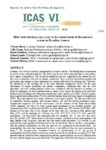Please use this identifier to cite or link to this item:
http://www.alice.cnptia.embrapa.br/alice/handle/doc/970204| Title: | Beef cattle stocking rate, a key to the conservation of the pastoral system in Brazilian biomes. |
| Authors: | ABREU, U.  GREGO, C.   FASIABEN, M.   GOMES, E.   ALMEIDA, M.   OLIVEIRA, O.   |
| Affiliation: | URBANO GOMES PINTO DE ABREU, CPAP; CÉLIA REGINA GREGO, CNPM; MARIA DO CARMO RAMOS FASIABEN, CNPTIA; ELIANE GONCALVES GOMES, SGE; MAXWELL ALMEIDA, IBGE; OCTÁVIO OLIVEIRA, IBGE. |
| Date Issued: | 2013 |
| Citation: | In: INTERANTIONAL CONFERENCE ON AGRICULTURAL STATISTICS, 6., 2013, Rio de Janeiro. Improving statistics for food Security, sustainable agriculture, and rural development. Rio de Janeiro: IBGE, 2013. |
| Pages: | Não paginado. |
| Description: | Abstract: In Brazil, beef cattle are raised in predominantly extensive systems. The feeding base is represented by native and/or cultivated pastures. The latter may be in a well conserved state or may present some degree of degradation. The amount of animals per hectare, supported by the pasture by each time unit, is basically related to the pasture production. There is interaction between quality and production, and changes in these parameters are strongly affected by the stocking rate. Therefore, the adjustment in the stocking rate is the most important management factor and the main determinant of animal production and pasture composition. Municipal data from the 2006 agriculture and cattle raising business census were considered with the objective to analyze, by means of typologies, the use of pastoral areas in Brazil. In the census, the producers declared their pastoral areas according to the following classification: native pasture areas (PN), cultivated pasture areas in good conservation status (PC) and cultivated pasture areas with some degree of degradation (PCD). They also indicated the number of bovine in each type of pasture. The data were submitted to exploratory factorial analysis, with varimax rotation. The first two factors (extracted by main components) explained 0.83 of the (co)variance, and the estimate of the Kaiser-Mayer-Olkin (KMO) adequacy test was 0.76, which meant good adjustment of the variables selected. The commonalities of the variables selected, PN area; total pasture area (TP), bovines in PN (Bov_PN); bovines in PCD area (Bov_PCD); bovines in PC area (Bov_PC); bovines in total pasture area (Bov_APT); and the stocking rate (TxLota) were 0.65; 0.97; 0.77; 0.74; 0.79; 0.87; and 0.99, respectively. The first factor was associated with the variables PN, TP, Bov_PN, Bov_PCD, Bov_PC, and Bov_APT, which directs to the latent variable correlated to those municipalities with large pasture areas, in general, and also with the largest cattle population. The variable TxLota presented the most significant factorial load in the second factor, that is, all those municipalities with the greatest concentration of cattle per unit area are represented in the second factor. The municipalities that were best represented in factor_1 are different from the ones represented in factor_2. The non-parametric correlation between the classifications of the two groups of municipalities formed by the factorial scores in the first and the second factors is small (0,24). This indicates that the context of those municipalities with the highest stocking rate is a lot different from the ones with the largest areas and cattle herds. The application of livestock development policies in the different Brazilian biomes should take into account all the distinguishing features of the municipalities, regarding their context, especially the pasture areas and their vocation for primary livestock production. |
| Thesagro: | Gado de Corte Uso da Terra |
| NAL Thesaurus: | Multivariate analysis Land use Beef cattle |
| Keywords: | Análise multivariada Tipologia |
| Notes: | ICAS VI. |
| Type of Material: | Artigo em anais e proceedings |
| Access: | openAccess |
| Appears in Collections: | Artigo em anais de congresso (CNPTIA)  |
Files in This Item:
| File | Description | Size | Format | |
|---|---|---|---|---|
| Beefcattle.pdf | 1.03 MB | Adobe PDF |  View/Open |









